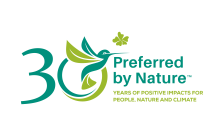Timber Risk Score: 98 / 100 in 2017. The Timber Legality Risk Assessment contains an evaluation of the risk of illegality in Australia for five categories and 21 sub-categories of law. We found:
- Specified risk for 3 sub-categories.
- Low risk for 18 sub-categories.
This page provides an overview of the legality risks related to timber produced in Australia.
17% (124 million ha) of Australia is covered by forests of which:
- About 4% is primary forest
- About 94% is naturally-regenerated forest
- About 2% is planted forest
Roundwood production totalled 32.1 million m3 in 2015. The forestry sector (including wood processing and pulp and paper) contributed USD 7.7 billion to the country’s economy in 2011, or nearly 1% of its GDP.
With the exception of sandalwood from the state of Western Australia, NEPCon has evaluated Australia as low risk for illegally harvested timber. Legality risks concerning the sourcing of sandalwood relate to legal rights to harvest, taxes and fees and trade and transport. Companies sourcing sandalwood from Western Australia should take care to ensure the risks identified are not present in your supply chains, or have been sufficiently mitigated. Companies sourcing other timber from Australia should still take care to ensure that risks are not present in their supply chains.
Score: 73 / 100 in 2021
Rank: 18 out of 180 countries in 2021
Harvesting of native sandalwood in Western Australia is limited by law (until 2026) to a maximum of 2,500 tonnes per year – 1,250 tonnes of green wood and 1,250 tonnes of dead wood
There are currently no armed conflicts in Australia according to the Council on Foreign Relations' Global Conflict Tracker
CITES appendix II: Dalbergia spp.
FSC Certified Forest Area: 1,214,846 hectares (4 December 2019).
PEFC Certified Forest Area: 11,365,106 hectares (31 December 2019).
Information Gathering
Timber sources
- Find out the different sources of legal timber
- Determine which source type your timber comes from
| Timber source | Description of source type |
|---|---|
|
Natural (native) forest on leasehold land |
Timber from natural forest on pastoral or indigenous leasehold land, managed privately or by government (or quasi-government) management agencies, often using contractors to harvest. |
|
Natural (native) “multiple use” forest |
Timber from natural forest designated for “multiple use” on state land, managed by State and Territory Government agencies (which may be vested in commercial entities). |
| Natural (native) forest in nature conservation reserves |
Timber from natural forest in nature conservation reserves (including national parks), managed by State and Territory Government agencies. |
| Natural (native) forestry on Other Crown land |
Timber from natural forest on private land, including Indigenous land, and managed by private entities. |
| Natural (native) sandalwood |
Timber from natural (native) sandalwood on public (Crown) land, managed by State and Territory Government agencies (Forest Products Commission) through contracts, and on private land (including indigenous land). |
| Industrial plantation on public leasehold land |
Timber from industrial plantations of exotic and native species on public and leasehold land, managed by State and Territory Government agencies (management may be vested in commercial entities that may own forest resource but not land). |
| Industrial plantation on private land |
Timber from industrial plantations of exotic and native species on private land, managed by probate entities. |
Risk Assessment
Risk assessment summary
|
Legal rights to harvest
|
|
|
Taxes and fees
|
|
|
Timber harvesting activities |
|
|
Third parties' rights
|
|
|
Trade and transport
|
|
Specified risk species
| Common/trade name | Scientific name | Risk information |
|---|---|---|
|
Sandalwood |
Santalum spicatum |
There is a known issue with illegal harvesting and export of sandalwood. Some estimates suggest that up to one third of the total export volume of about 1,600 tonnes is illegally harvested. As an absolute number, this is a small amount; but as a proportion of as highly valued species, it is substantial. |
Risk Mitigation
Mitigate the risks in your supply chain
Learn which actions we recommended to mitigate the risks associated with the timber sources from Australia.
Source Certified Materials
NEPCon believes that third party certification (for example FSC and PEFC certification) can provide strong assurances of the legality of the products they cover. Companies seeking to mitigate the risks of sourcing illegal timber should seek to purchase third party certified materials wherever possible.
While the European Timber Regulation does not include an automatic “green lane” for certified products, it does recognise the value of certification as a tool for risk assessment and mitigation. The European Commission says that companies “may rate credibly certified products as having negligible risk of being illegal, i.e. suitable for placing on the market with no further risk mitigation measures, provided that the rest of the information gathered and the replies to the risk assessment questions do not contradict such a conclusion.”
For more information on using certified materials in your due diligence, including how to assess whether a certification system meets EUTR requirements, see the page on Certification and Due Diligence.
Mitigation recommendations
Below is a summary of our recommended actions to mitigate the risks associated with timber sources from Australia.
1. Fully map your supply chain
- Our supply chain mapping tool can help you do this.
2. Obtain and verify documents
- Obtain copies of harvest permits and other documentation associated with wild sandalwood (e.g. Sandalwood licence, Commercial Producer’s Licence, Commercial Purposes Licence - depending on tenure of harvest area) and confirm their validity with authorities.
3. Consult stakeholders
- Stakeholders confirm that information regarding area, species, volumes and other details given in the sandalwood harvesting permit is correct and within limits prescribed in the legislation.
4. Carry out on-site verification
- Confirm that sandalwood harvesting takes place within limits given in the harvesting or extraction permit.
5. Conduct targeted timber testing
- Conduct timber testing on samples of purchased sandalwood to verify the species or origin of timber, where appropriate.











